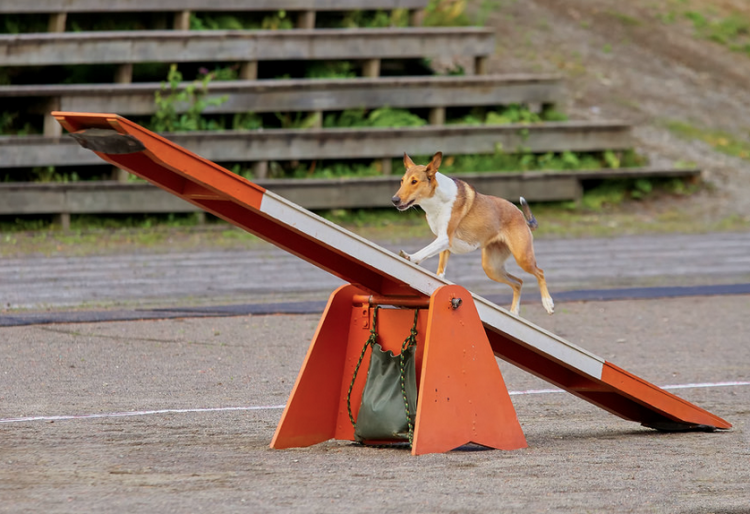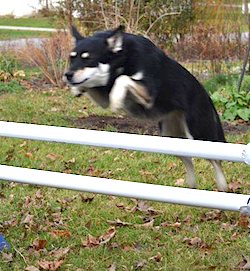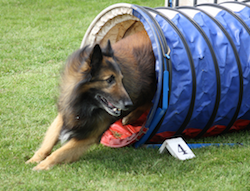
Curious about how to make your own dog agility course? Check out some of these important DIY tips that can help you build your own dog agility course in a way that can also save you money.
One of our amazing dogs is a Lagotto Romagnolo. He is one of only about 1,000 of the rare breed in the country.
Luke is a beauty. Unfortunately, he is about 10 pounds and an inch or so outside the breed standard, so he can’t compete in a show ring. My husband, ever vigilant to bring the Lagotto breed to the public’s attention, decided Luke would be an awesome agility champion.
Canine agility competitions represent one of the fastest-growing sports in the United States. Agility courses are designed to demonstrate athletic ability and stamina as well as the team effort between the handler and the dog.
Official canine agility trials originated in Birmingham, England, in 1978. The American Kennel Club sanctioned the sport in the US in 1994. Today there are more than 2,000 AKC competitions across the country. It is a spectator sport enjoyed by young and old alike.
The Right Gear
When planning our backyard dog agility course, we researched the AKC regulation equipment along with expert training guidelines on how to build a dog obstacle course.
Several pet equipment companies offer an online catalog of sanctioned gear, so we ordered a base supply of weave poles, jumps, tunnel, teeter board and a pause table. The expensive DIY dog agility course equipment arrived a short time later. My husband opened the boxes to discover what appeared to be debris from a plumbing construction site along with instructions for assembly.
I am not saying our purchase was misrepresented. Indeed, the equipment is standard gear — but a trip to any home improvement store and a 20-minute Internet search would have save us a considerable amount of money. I will pass our lesson, including cost-saving tips, along to Petful readers.
Agility 101: The Basics
A basic dog agility course consists of:
- Jumps (standard pole and tire)
- Tunnels
- Teeter
- Weave poles
- Pause table
The equipment used for a dog agility course is regulated by height and width and determined by size and breed of dog. When you start building a dog agility course in your backyard, consider space and refer to the AKC agility information for your dog’s recommended adjustments.
Make Your Own Dog Agility Course
Standard Jump – Retails for $50-$200
Jumps represent the core of a DIY dog obstacle course. Jumps are presented in a variety of complex configurations including winged, wingless, double jumps and spread jumps. Each more complicated but with the same essential construction of poly vinyl chloride (PVC) pipes. PVC pipes are used in modern plumbing projects (and countless DIY projects), and an impressive array of PVC pipes and fittings is available at any plumbing supply or home improvement store.

The standard jump (hurdle) we purchased for $115 (not including shipping, handling or taxes) consisted of the same stuff you can buy yourself much cheaper individually:
- 4 – 18 inch length PVC pipes (PVC pipe is sold at Lowe’s Home Improvement Stores for $3.02 per 5 ft length, and they will cut your required length for free
- 2 – 2 ¾ inch length PVC pipes
- 3 – 4 inch length PVC pipes
- 4 PVC T’s ($4.50 each)
- PVC end caps (68 cents each)
Approximate cost of DIY standard jump: $17.50
Tire Jump – Retails for $120-$175
The tire jump was possibly our biggest surprise. We had assumed from the catalog pictures that the brightly colored apparatus was a technological marvel. The reality: Not so much. Here is the list of what you will need to make your own professional tire jump — just like those used in sanctioned meets:
- 4 – 18 inch length of 1 inch PVC pipe
- 2 – 36 inch length of 1 inch PVC pipe
- 4 – 1 1/2 inch PVC elbows ($2 each)
- 2 – PVC T’s ($4.50 each)
- 1 – flex drain pipe measured and cut to fit your dog’s girth, 8 feet length ($5.50)
- 1 – drain coupler ($2)
- 1 – 12 inch length link chain ($1 per ft)
- 3 rolls duct tape (1 red, 1 white, 1 blue) ($3.50 per roll)
Approximate cost of DIY tire jump: $45

Weave Poles – Retails for $50 per section
Weave poles test a dog’s agility and ability to navigate the complex order of the poles. We bought a run of four sets (two poles per set) for $200. The same PVC pipes can accomplish a regulation weave pole apparatus for $9. To complete the project you will need:
- 8 – 36 inch length PVC pipes
- 4 – 18 inch length PVC pipes
- 2 – ¼ inch PVC pipes
- 10 – PVC T’s ($4.50 each)

Approximate cost for a four-set run of DIY obstacle weave poles: $65
Tunnel – Retails for $175-$200
The DIY dog tunnel was a bit more complex. Because of the wiring and construction of the actual tunnel, I just shopped for a child’s play tunnel. I found a 6 ft collapsible tunnel for under $20. Add four small landscape fabric pins for anchors at $4 for a bag of 25, and you have a DIY dog tunnel for less than $25– and no assembly!
Was YOUR Pet Food Recalled?
Check Now: Blue Buffalo • Science Diet • Purina • Wellness • 4health • Canine Carry Outs • Friskies • Taste of the Wild • See 200+ more brands…


Teeter Board – Retails for $50-$75
Think of an old-fashioned child’s see saw, and you have the image of an agility teeter board. To build your own teeter board, assemble:
- 8 – 1 inch 90-degree PVC elbows ($2 each)
- 6 – PVC T’s ($4.50 each)
- 4 – 2 ¼ inch PVC pipes
- 5 – 5 ½ inch PVC pipes
- 9 – 12 inch PVC pipes
- 1 – 10 inch PVC pipe
- 1 – 2 inch x 10 inch board ($7)
- 2 – 6 inch pipe straps ($1.50)
- Assorted screws (screw kit, $4)
- Astroturf or grass carpet for cover, 4 ft x 8 ft rug ($20)
Approximate cost of DIY teeter board: $82

Assuming you can recycle materials from other projects, you can reduce production expenses. Otherwise, it may be better to just buy a teeter board.
Pause Table – Retails for $80-$180
Depending on the size of your dog, pause tables can range significantly in price. Their purpose is to provide a break for your dog to regroup and stay during meets. Their ability to stay on the pause table is scored, so it is an important training routine.
A visit to a local utility provider or warehouse supply company may be your best source for the base of a pause table. Ask for cable spools. They are sturdy and do not tip easily. Some utility companies discard the spools when the cable has been used. In addition to the base you will need:
- Particle board cut to cover the top of the spool, 24 inches x 48 inches ($8)
- Astroturf or grass carpet to cover the board, 4 ft x 8 ft rug ($20)
- Tacks or carpet glue to fasten the carpet to the board, 8 ounces ($3.50)
Approximate cost of DIY pause table: less than $30

More Cost-Cutting Tips
The cost estimates for the DIY dog agility course projects detailed are based on buying all materials at retail. Additional savings may be realized by:
- Shopping thrift stores, yard sales and flea markets for materials
- Looking for discount sale items
- Recycling materials from around the house
- Browsing online “for sale by owner” sites like eBay and Craigslist for used agility equipment
Help and Instructions
The American Kennel Club website is a great source of information to consider when planning how to make a dog agility course and training for your dog. I also found that Caninecrib.com provided an excellent, easy DIY manual for assembling each piece of agility equipment. That online guide comes complete with step-by-step instructions and pictures.
Be sure to check with your veterinarian before beginning agility training to ensure your dog is physically capable. Do not push him beyond his comfortable physical limits.
As for my dog, Luke, I am not sure he will ever compete at the national level for an agility championship. I do know the mental stimulation and physical exercise we all enjoy as a result of the agility training is the true benefit. It doesn’t take a ribbon or trophy to see our dog is a real champion in our book!
Photos, top to bottom: tretjakovgallery, greengardenvienna, N8tr0n, arkuin, Daisyree Bakker, arkuin and arkuin/Flickr


